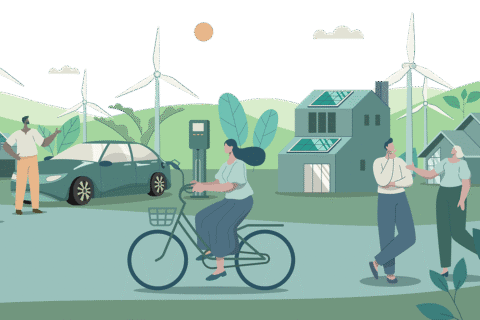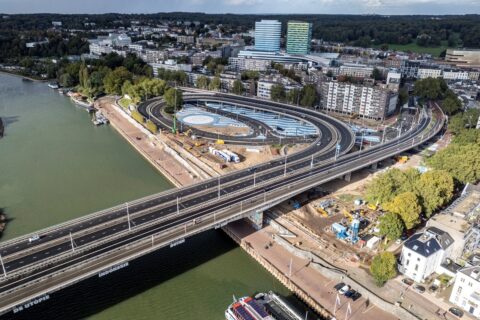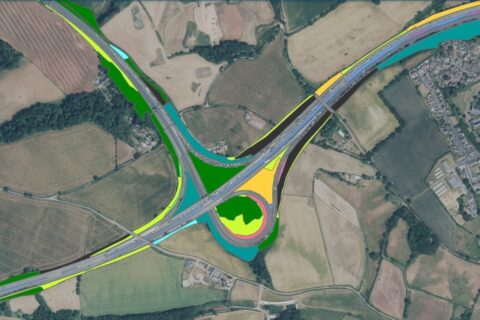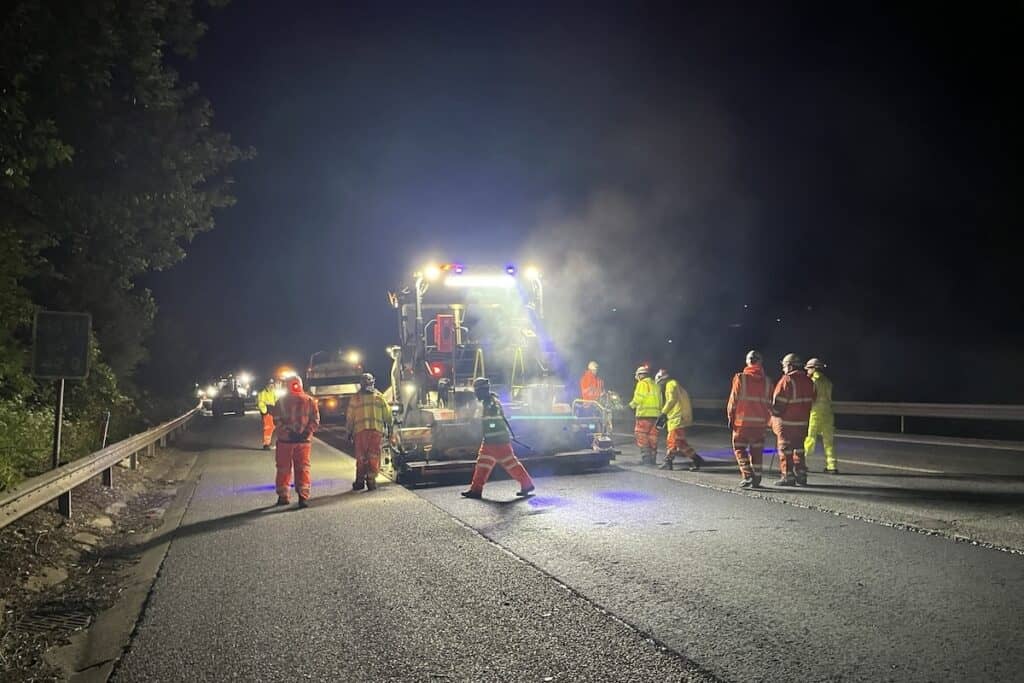
Trials of an innovative carbon-negative aggregate are taking place on a stretch of motorway in England, as part of a drive to shrink the footprint of works to modernise, maintain and operate main highways.
The next-generation construction material was identified in a competition run by National Highways, the wholly government-owned company responsible for England’s motorways and major A roads.
As a result of the Accelerating Low Carbon Innovation competition, launched last year in collaboration with Connected Places Catapult, four firms received up to £80,000 each to make their vision a reality.
Now, the first of those – Seaham-based company Low Carbon Materials — has been able to trial their ACLA carbon-negative aggregate on a National Highways road for the first time.
With support from construction giants Skanska and Tarmac, the trial is taking place on the northbound carriageway of the M11 in Essex. Incorporated into essential resurfacing and maintenance work between junctions 7 and 8, it will be subject to real-world levels of heavy traffic and routine monitoring.
A test strip of asphalt concrete binder course containing LCM’s product has been laid alongside a control sample containing 100% conventional aggregate. It is hoped the carbon-negative aggregate will make a significant impact on carbon emissions with minimal change to standard procedures.
Real-world testing in heavy traffic
Testing is key, says Dr Joanna White, Research, Development and Innovation Director, National Highways:
“Solutions like this could have a real impact on our route to net zero carbon so we are delighted that we have been able to accelerate the development of the product and get it on one of our roads for testing.
“Testing the asphalt in real conditions on a heavily trafficked motorway, under close scrutiny, will be far more effective in proving the durability of the product and hopefully its success.”
The ACLA solution is simple and scalable, says Natasha Boulding, CEO at Low Carbon Materials, which was also nominated in 2022 as a finalist in Prince William’s prestigious Earthshot Prize to ‘Fix our Climate’:
“We are excited by National Highways’ recognition of the potential of our carbon-negative aggregate. A motorway trial represents a significant step towards lower carbon roads and widespread adoption.”
Industry collaboration to accelerate trial
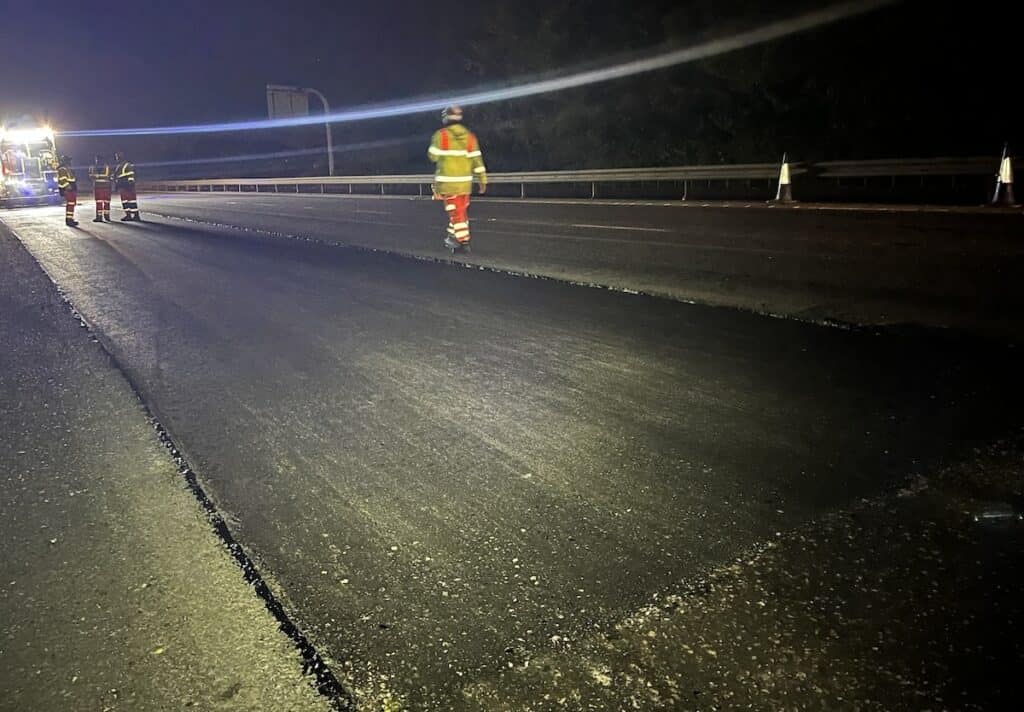
The programme matched Tier 1 contractor Skanska and existing supply chain partner Tarmac with the SME, Low Carbon Materials. Working together, the challenge was to responsibly bring LCM’s new ACLA product to market as quickly as possible, explains Skanska Chief Engineer Paul Cole:
“Within an eight-month period a new material has been thoroughly tested against Highway Specifications and successfully trialled on the National Highways strategic road network. Eight months ago I didn’t believe that would be possible. It is amazing what can be achieved through effective collaboration.”
The trial is a testament to teamworking, agrees Tim Smith, senior technical manager (South East), Tarmac:
“Fast-tracking this new material in record time represents another important example of how our industry can rapidly develop innovations, getting them from the laboratory and out onto the road network.”
Ring-fenced funding to drive innovation
Working with the UK innovation accelerator Connected Places Catapult, National Highways shortlisted seven entries in total under the Accelerating Low Carbon Innovation programme.
This is the latest competition run with the help of Designated Funds, which provides ring-fenced monies for initiatives that deliver lasting benefits for road users, the environment and communities across England.
The other three firms that made it through to the final stage of the programme are:
- PRG (Scotland) Limited, Hamilton — who produce a bitumen-like substance from waste tyres which would be useful for road construction and repairs;
- Circular11 Ltd, Christchurch, Dorset — who provide highly durable, maintenance-free fencing material that turns mixed low-grade plastic into low-carbon infrastructure, collected and recycled at end-of-life;
- Asset International Structures, Cwmbran — who develop smart fibre reinforced polymer bridge beams incorporating a novel optical fibre, enabling real-time long-term structural performance monitoring.
A big benefit of the competition is that multiple entries enjoy success and support, concludes Executive Director of SME Development and Academic Engagement at Connected Places Catapult, Alex Weedon:
“Innovative companies on the programme have been supported by the Catapult with investment, business and marketing support; and it is great to see each of them develop their ideas and make good progress towards getting their innovations to be used in real-world environments.”
Further Reading:
- More about National Highways; plus its current research and innovation competitions;
- More about the UK innovation accelerator Connected Places Catapult;
- Also on SustMeme, Satellites and AI to map biodiversity of highways;
- Also on SustMeme, New US protocol created for low-carbon cement;
- Also on SustMeme, Quarry waste on the road to circular construction;
- Also on SustMeme, Scottish facility wins £500K grant to support circular cement;
- Also on SustMeme, Is a fossil-free future within reach for steel?
Check out the full archive of stories on the SustMeme Built Environment Channel, Sponsored by Mitsubishi Electric Living Environmental Systems UK.

